Chemistry > HESI > Chemistry, 10e (Brown) Molecular Geometry and Bonding Theories TEST BANK | GRADED A+ (All)
Chemistry, 10e (Brown) Molecular Geometry and Bonding Theories TEST BANK | GRADED A+
Document Content and Description Below
Chemistry, 10e (Brown) Chapter 9, Molecular Geometry and Bonding Theories Multiple-Choice and Bimodal 1) For a molecule with the formula AB2 the molecular shape is _ . A) lin... ear or bent B) linear or trigonal planar C) linear or T-shaped D) T-shaped E) trigonal planar 2) According to VSEPR theory, if there are five electron domains in the valence shell of an atom, they will be arranged in a(n) geometry. A) octahedral B) linear C) tetrahedral D) trigonal planar E) trigonal bipyramidal 3) According to VSEPR theory, if there are four electron domains in the valence shell of an atom, they will be arranged in a(n) geometry. A) octahedral B) linear C) tetrahedral D) trigonal planar E) trigonal bipyramidal 4) The electron-domain geometry and molecular geometry of iodine trichloride are and , respectively. A) trigonal bipyramidal, trigonal planar B) tetrahedral, trigonal pyramidal C) trigonal bipyramidal, T-shaped D) octahedral, trigonal planar E) T-shaped, trigonal planar 5) The molecular geometry of is square planar. A) CCl4 B) XeF4 C) PH3 D) XeF2 E) ICl3 6) The molecular geometry of the H3O+ ion is . A) linear B) tetrahedral C) bent D) trigonal pyramidal E) octahedral 7) The molecular geometry of the CS2 A) linear B) bent C) tetrahedral D) trigonal planar E) T-shaped 8) The molecular geometry of the SiH2Cl2 molecule is . A) trigonal planar B) tetrahedral C) trigonal pyramidal D) octahedral E) T-shaped 9) The molecular geometry of the PHCl2 molecule is . A) bent B) trigonal planar C) trigonal pyramidal D) tetrahedral E) T-shaped 10) The molecular geometry of the CHCl3 A) bent B) trigonal planar C) trigonal pyramidal D) tetrahedral E) T-shaped A 11) The molecular geometry of the SF2 molecule is . A) linear B) bent C) trigonal planar D) tetrahedral E) octahedral 12) The molecular geometry of the PF2+ ion is . A) octahedral B) tetrahedral C) trigonal pyramidal D) trigonal planar E) trigonal bipyramidal 13) The F–B–F bond angle in the BF2- ion is approximately . A) 90° B) 109.5° C) 120° D) 180° E) 60° 14) The Cl–Si–Cl bond angle in the SiCl2F2 molecule is approximately . A) 90° B) 109.5° C) 120° D) 180° E) 60° 15) The F–B–F bond angle in the BF3 molecule is . A) 90° B) 109.5° C) 120° D) 180° E) 60° 16) The O–S–O bond angle in SO2 is slightly less than . A) 90° B) 109.5° C) 120° D) 180° E) 60° 17) The F–N–F bond angle in the NF3 molecule is slightly less than . A) 90° B) 109.5° C) 120° D) 180° E) 60° 18) According to valence bond theory, which orbitals on bromine atoms overlap in the formation of the bond in Br2 ? A) 3s B) 3p C) 4s D) 4p E) 3d 19) The electron-domain geometry of a sulfur-centered compound is trigonal bipyramidal. The hybridization of the central nitrogen atom is . A) sp B) sp2 C) sp3 D) sp3d E) sp3d2 20) The hybridization of orbitals on the central atom in a molecule is sp. The electron-domain geometry around this central atom is . A) octahedral B) linear C) trigonal planar D) trigonal bipyramidal E) tetrahedral 21) The hybridization of orbitals on the central atom in a molecule is sp2. The electron-domain geometry about this central atom is . A) octahedral B) linear C) trigonal planar D) trigonal bipyramidal E) tetrahedral 22) The hybridization of the carbon atom in carbon dioxide is . A) sp B) sp2 C) sp3 D) sp3d E) sp3d2 23) The hybridization of the central atom in the XeF4 molecule is . A) sp B) sp2 C) sp3 D) sp3d E) sp3d2 24) The electron-domain geometry of the AsF6 - ion is octahedral. The hybrid orbitals used by the As atom for bonding are orbitals. A) sp2d2 B) sp3 C) sp3d D) sp3d2 E) sp2 25) In order to produce sp3 hybrid orbitals, s atomic orbital(s) and p atomic orbital(s) must be mixed. A) one, two B) one, three C) one, one D) two, two E) two, three A 26) The angles between sp2 orbitals are . A) 45° B) 180° C) 90° D) 109.5° E) 120° 27) There are σ and π bonds in the H–C≡C–H molecule. A) 3 and 2 B) 3 and 4 C) 4 and 3 D) 2 and 3 E) 5 and 0 28) There are σ and π bonds in the H2C=C=CH2 molecule. A) 4, 2 B) 6, 4 C) 2, 2 D) 2, 6 E) 6, 2 29) The total number of π bonds in the H–C≡C–C≡C–C≡N molecule is . A) 3 B) 4 C) 6 D) 9 E) 12 30) There is/are σ bond(s) in the molecule below. A) 1 B) 2 C) 12 D) 13 E) 18 31) There is/are π bond(s) in the molecule below. A) 0 B) 1 C) 2 D) 4 E) 16 32) There is/are π bond(s) in the molecule below. A) 7 B) 6 C) 2 D) 1 E) 0 33) The Lewis structure of carbon monoxide is given below. The hybridizations of the carbon and oxygen atoms in carbon monoxide are and , respectively. : C ≡ O : A) sp, sp3 B) sp2 , sp3 C) sp3 , sp2 D) sp, sp E) sp2 , sp2 Multiple-Choice 34) The basis of the VSEPR model of molecular bonding is . A) regions of electron density on an atom will organize themselves so as to maximize s-character B) regions of electron density in the valence shell of an atom will arrange themselves so as to maximize overlap C) atomic orbitals of the bonding atoms must overlap for a bond to form D) electron domains in the valence shell of an atom will arrange themselves so as to minimize repulsions E) hybrid orbitals will form as necessary to, as closely as possible, achieve spherical symmetry 35) According to VSEPR theory, if there are three electron domains in the valence shell of an atom, they will be arranged in a(n) geometry. A) octahedral B) linear C) tetrahedral D) trigonal planar E) trigonal bipyramidal 36) In counting the electron domains around the central atom in VSEPR theory, a is not included. A) nonbonding pair of electrons B) single covalent bond C) core level electron pair D) double covalent bond E) triple covalent bond 37) The electron-domain geometry of is tetrahedral. A) CBr4 B) PH3 C) CCl2BR2 D) XeF4 E) all of the above except XeF4 38) The O–C–O bond angle in the CO32- ion is approximately . A) 90° B) 109.5° C) 120° D) 180° E) 60° 39) The Cl–C–Cl bond angle in the CCl2O molecule (C is the central atom) is slightly . A) greater than 90° B) less than 109.5° C) less than 120° D) greater than 120° E) greater than 109.5° 40) Of the following species, _ will have bond angles of 120°. A) PH3 B) ClF3 C) NCl3 D) BCl3 E) All of these will have bond angles of 120°. 41) The molecular geometry of the BrO3 - ion is . A) trigonal pyramidal B) trigonal planar C) bent D) tetrahedral E) T-shaped 42) The molecular geometry of the left-most carbon atom in the molecule below is . A) trigonal planar B) trigonal bipyramidal C) tetrahedral D) octahedral E) T-shaped 43) The molecular geometry of the right-most carbon in the molecule below is . A) trigonal planar B) trigonal bipyramidal C) tetrahedral D) octahedral E) T-shaped 44) The bond angles marked a, b, and c in the molecule below are about , , and , respectively. A) 90°, 90°, 90° B) 120°, 120°, 90° C) 120°, 120°, 109.5° D) 109.5°, 120°, 109.5° E) 109.5°, 90°, 120° 45) The bond angles marked a, b, and c in the molecule below are about , , and , respectively. A) 109.5°, 109.5°, 109.5° B) 120°, 109.5°, 120° C) 109.5°, 109.5°, 120° D) 90°, 180°, 90° E) 109.5°, 109.5°, 90° 46) The bond angle marked a in the following molecule is about . A) 90° B) 109.5° C) 120° D) 180° E) 60° 47) The central iodine atom in the ICl4 - ion has nonbonded electron pairs and bonded electron pairs in its valence shell. A) 2, 2 B) 3, 4 C) 1, 3 D) 3, 2 E) 2, 4 48) The central iodine atom in IF5 has unbonded electron pairs and bonded electron pairs in its valence shell. A) 1, 5 B) 0, 5 C) 5, 1 D) 4, 1 E) 1, 4 49) The central Xe atom in the XeF4 molecule has unbonded electron pairs and bonded electron pairs in its valence shell. A) 1, 4 B) 2, 4 C) 4, 0 D) 4, 1 E) 4, 2 50) An electron domain consists of . a) a nonbonding pair of electrons b) a single bond c) a multiple bond A) a only B) b only C) c only D) a, b, and c E) b and c 51) According to VSEPR theory, if there are three electron domains on a central atom, they will be arranged such that the angles between the domains are . A) 90° B) 180° C) 109.5° D) 360° E) 120° 52) According to VSEPR theory, if there are four electron domains on a central atom, they will be arranged such that the angles between the domains are . A) 120° B) 109.5° C) 180° D) 360° E) 90° 53) According to VSEPR theory, if there are two electron domains on a central atom, they will be arranged such that the angles between the domains are . A) 360° B) 120° C) 109.5° D) 180° E) 90° 54) The electron-domain geometry and the molecular geometry of a molecule of the general formula ABn are . A) never the same B) always the same C) sometimes the same D) not related E) mirror images of one another 55) The electron-domain geometry and the molecular geometry of a molecule of the general formula ABn will always be the same if . A) there are no lone pairs on the central atom B) there is more than one central atom C) n is greater than four D) n is less than four E) the octet rule is obeyed 56) For molecules of the general formula ABn , n can be greater than four . A) for any element A B) only when A is an element from the third period or below the third period C) only when A is boron or beryllium D) only when A is carbon E) only when A is Xe Consider the following species when answering the following questions: (i) PCl3 (ii) CCl4 (iii) TeCl4 (iv) XeF4 (v) SF6 57) For which of the molecules is the molecular geometry (shape) the same as the VSEPR electron domain arrangement (electron domain geometry)? A) (i) and (ii) B) (i) and (iii) C) (ii) and (v) D) (iv) and (v) E) (v) only 58) Of the molecules below, only is polar. A) SbF5 B) AsH3 C) I2 D) SF6 E) CH4 59) Of the molecules below, only is nonpolar. A) CO2 B) H2O C) NH3 D) HCl E) TeCl2 60) Of the molecules below, only is polar. A) CCl4 B) CH4 C) SeF4 D) SiCl4 E) BF4 61) Of the molecules below, only is nonpolar. A) BF3 B) NF3 C) IF3 D) PBr3 E) BrCl3 62) Three monosulfur fluorides are observed: SF2 , SF4 , and SF6 . Of these, is/are polar. A) SF2 only B) SF2 and SF4 only C) SF4 only D) SF6 only E) SF2 , SF4 , and SF6 63) The molecular geometry of the BeCl2 molecule is , and this molecule is . A) linear, nonpolar B) linear, polar C) bent, nonpolar D) bent, polar E) trigonal planar, polar 64) The molecular geometry of the PF3 molecule is , and this molecule is . A) trigonal planar, polar B) trigonal planar, nonpolar C) trigonal pyramidal, polar D) trigonal pyramidal, nonpolar E) tetrahedral, unipolar 65) Of the following molecules, only is polar. A) BeCl2 B) BF3 C) CBr4 D) SiH2Cl2 E) Cl2 66) Of the following molecules, only is polar. A) CCl4 B) BCl3 C) NCl3 D) BeCl2 E) Cl2 67) For molecules with only one central atom, how many lone pairs on the central atom guarantees molecular polarity? A) 1 B) 2 C) 1 or 2 D) 3 E) 1 or 3 68) The molecular geometry of the CHF3 molecule is , and the molecule is . A) trigonal pyramidal, polar B) tetrahedral, nonpolar C) seesaw, nonpolar D) tetrahedral, polar E) seesaw, polar 69) The molecular geometry of the BCl3 molecule is , and this molecule is . A) trigonal pyramidal, polar B) trigonal pyramidal, nonpolar C) trigonal planar, polar D) trigonal planar, nonpolar E) trigonal bipyramidal, polar 70) According to valence bond theory, which orbitals overlap in the formation of the bond in HBr? A) 1s on H and 4p on Br B) 1s on H and 4s on Br C) 1s on H and 3p on Br D) 2s on H and 4p on Br E) 2s on H and 3p on Br 71) The combination of two atomic orbitals results in the formation of molecular orbitals. A) 1 B) 2 C) 3 D) 4 E) 0 72) The electron-domain geometry of a carbon-centered compound is tetrahedral. The hybridization of the central carbon atom is . A) sp B) sp2 C) sp3 D) sp3d E) sp3d2 73) Of the following, only has sp2 hybridization of the central atom. A) PH3 B) CO32- C) ICl3 D) I3 - E) PF5 74) Of the following, the central atom is sp3d2 A) PCl5 B) XeF4 C) PH3 D) Br3 - E) BeF2 hybridized only in _ . 75) The sp3d2 A) 2 B) 3 C) 4 D) 5 E) 6 76) The sp2 atomic hybrid orbital set accommodates electron domains. A) 2 B) 3 C) 4 D) 5 E) 6 77) The hybridizations of nitrogen in NF3 and NH3 are and , respectively. A) sp2 , sp2 B) sp, sp3 C) sp3 , sp D) sp3 , sp3 E) sp2 , sp3 78) The hybridizations of iodine in IF3 and IF5 are and , respectively. A) sp3 , sp3d B) sp3d , sp3d2 C) sp3d , sp3 D) sp3d2 , sp3d E) sp3d2 , sp3d2 79) The hybridizations of bromine in BrF5 and of arsenic in AsF5 respectively. A) sp3 , sp3d B) sp3d , sp3d2 C) sp3d , sp3 D) sp3d2 , sp3d E) sp3d2 , sp3d2 Answer: D are and , 80) The hybrid orbitals used for bonding by the sulfur atom in the SF4 molecule are orbitals. A) sp B) sp2 C) sp3 D) sp3d E) sp3d2 81) The hybrid orbitals used for bonding by Xe in the unstable XeF2 molecule are orbitals. A) sp2 B) sp3 C) sp3d D) sp3d2 E) sp 82) The hybridization of the oxygen atom labeled y in the structure below is . The C–O–H bond angle is . A) sp, 180° B) sp2 , 109.5° C) sp3 , 109.5° D) sp3d2 , 90° E) sp, 90° 83) The electron-domain geometry of the AsF5 molecule is trigonal bipyramidal. The hybrid orbitals used by the As atom for bonding are orbitals. A) sp2d2 B) sp3 C) sp3d2 D) sp3d E) sp2 84) hybrid orbitals are used for bonding by Xe in the XeF4 molecule. A) sp2 B) sp3 C) sp3d D) sp3d2 E) sp Consider the following species when answering the following questions: (i) PCl3 (ii) CCl4 (iii) TeCl4 (iv) XeF4 (v) SF6 85) In which of the molecules does the central atom utilize d orbitals to form hybrid orbitals? A) (i) and (ii) B) (iii) only C) (i) and (v) D) (iii), (iv), and (v) E) (v) only 86) Which of the molecules has a see-saw shape? A) (i) B) (ii) C) (iii) D) (iv) E) (v) A 87) In which of the molecules is the central atom sp3d2 A) (i) and (ii) B) (iii) only C) (iii) and (iv) D) (iv) and (v) E) (v) only Answer: D Diff: 1 Page Ref: Sec. 9.5 hybridized? 88) There are unhybridized p atomic orbitals in an sp-hybridized carbon atom. A) 0 B) 1 C) 2 D) 3 E) 4 Answer: C Diff: 1 Page Ref: Sec. 9.5 89) When three atomic orbitals are mixed to form hybrid orbitals, how many hybrid orbitals are formed? A) one B) six C) three D) four E) five Answer: C Diff: 1 Page Ref: Sec. 9.5 90) The blending of one s atomic orbital and two p atomic orbitals produces . A) three sp hybrid orbitals B) two sp2 hybrid orbitals C) three sp3 hybrid orbitals D) two sp3 hybrid orbitals E) three sp2 hybrid orbitals Answer: E Diff: 1 Page Ref: Sec. 9.5 91) A triatomic molecule cannot be linear if the hybridization of the central atoms is . A) sp B) sp2 C) sp3 D) sp2 or sp3 E) sp2 d or sp3d2 Answer: D Diff: 1 Page Ref: Sec. 9.5 92) A typical double bond . A) is stronger and shorter than a single bond B) consists of one σ bond and one π bond C) imparts rigidity to a molecule D) consists of two shared electron pairs E) All of the above answers are correct. Answer: E Diff: 1 Page Ref: Sec. 9.6 93) A typical triple bond . A) consists of one σ bond and two π bonds B) consists of three shared electrons C) consists of two σ bonds and one π bond D) consists of six shared electron pairs E) is longer than a single bond Answer: A Diff: 1 Page Ref: Sec. 9.6 [Show More]
Last updated: 1 year ago
Preview 1 out of 34 pages
Instant download

Buy this document to get the full access instantly
Instant Download Access after purchase
Add to cartInstant download
Reviews( 0 )
Document information
Connected school, study & course
About the document
Uploaded On
Mar 13, 2021
Number of pages
34
Written in
Additional information
This document has been written for:
Uploaded
Mar 13, 2021
Downloads
0
Views
108


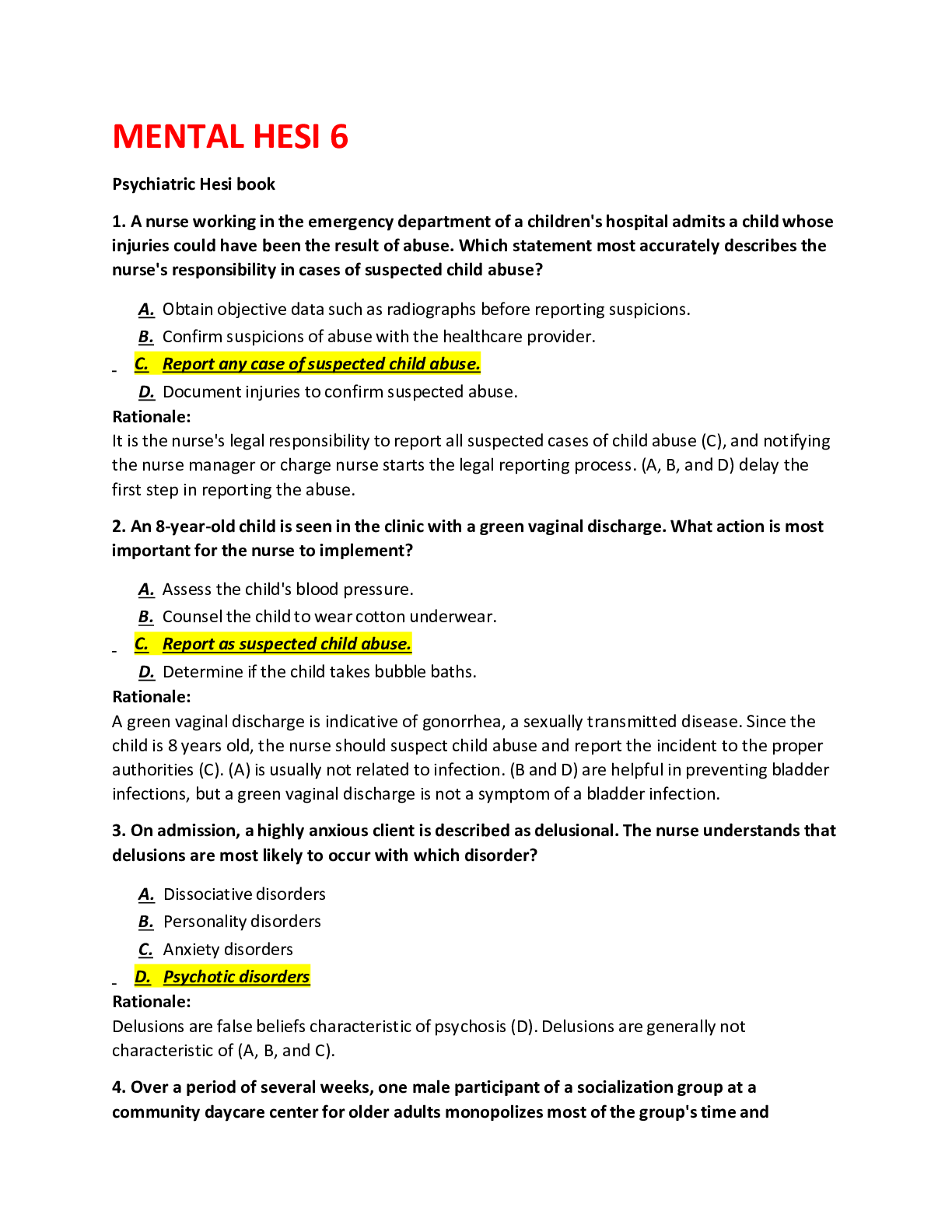
.png)


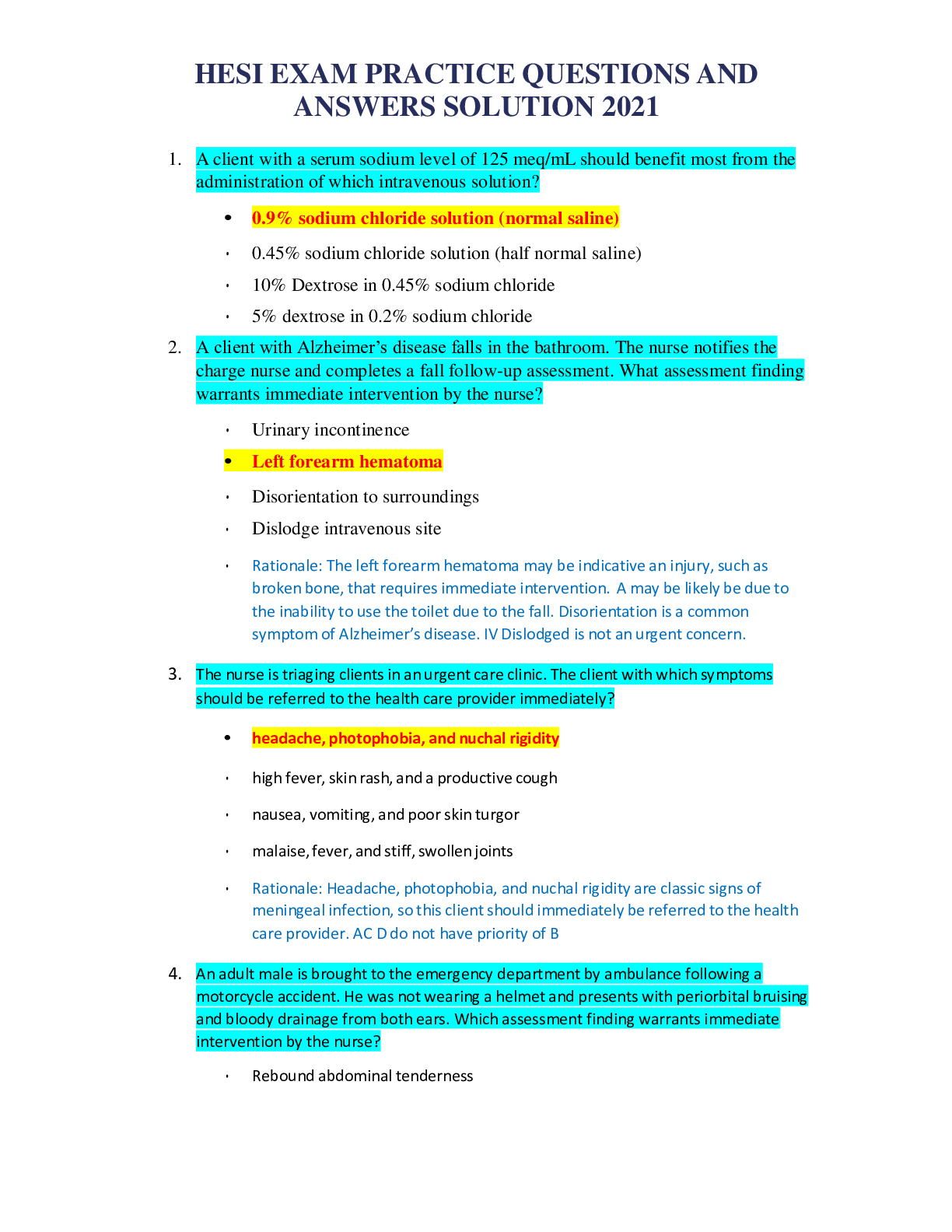
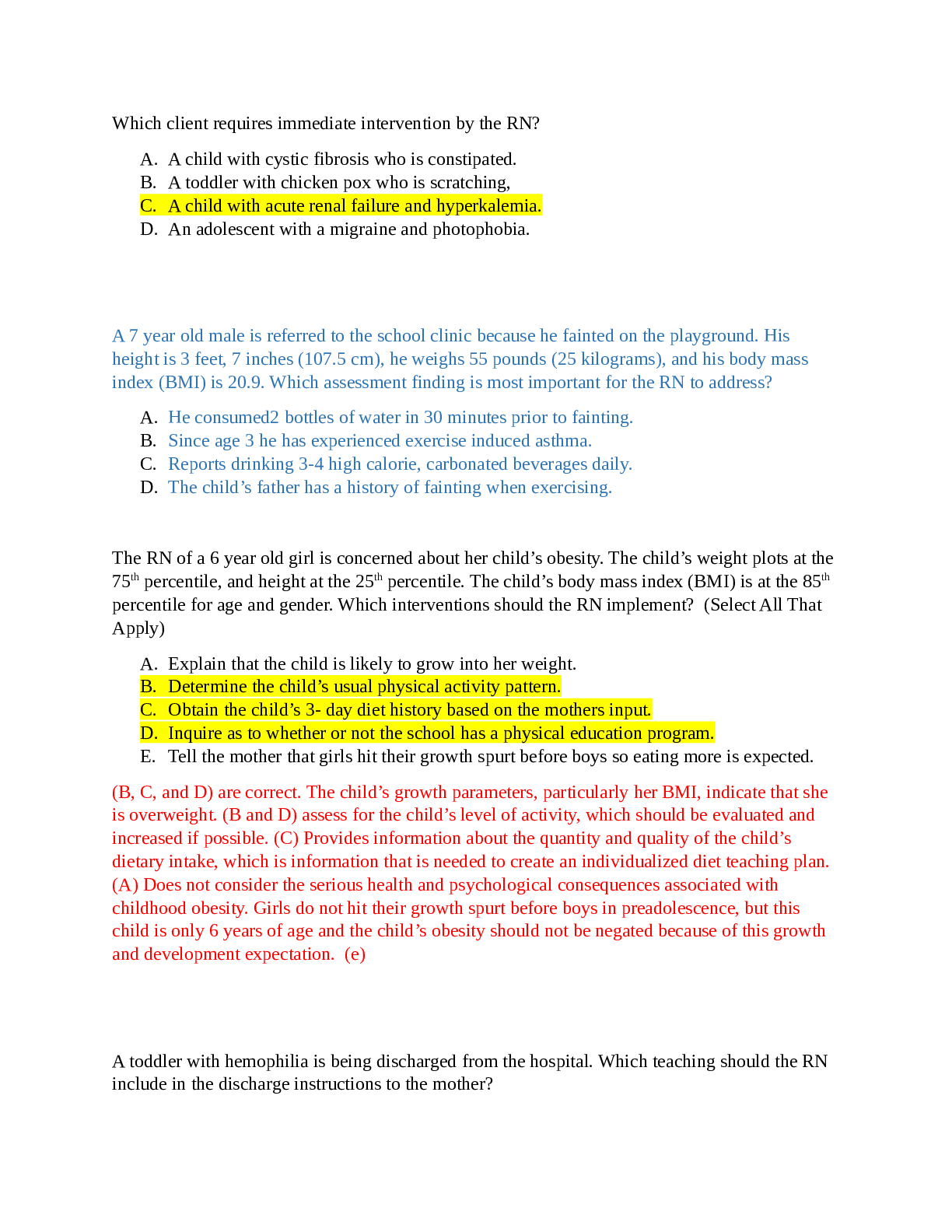
.png)




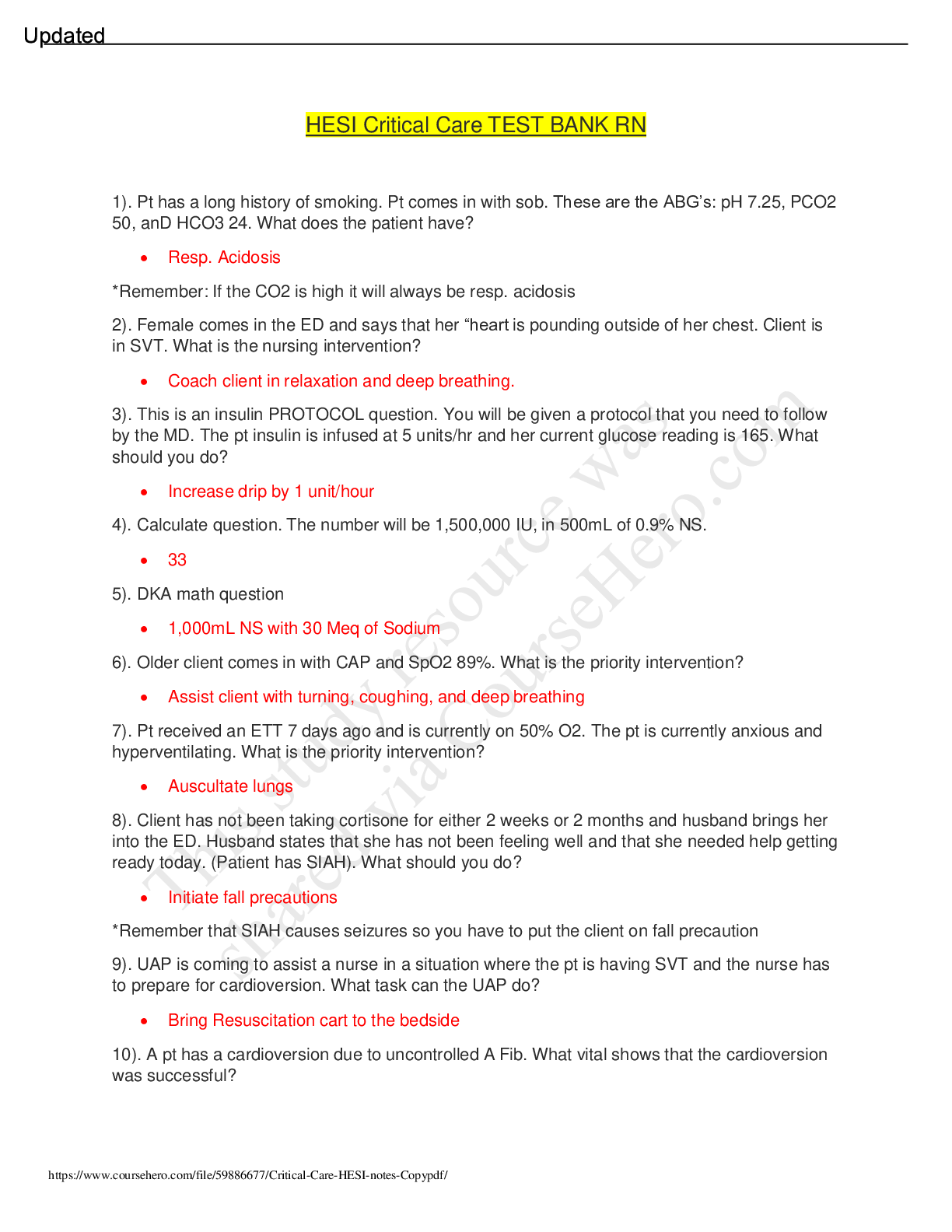
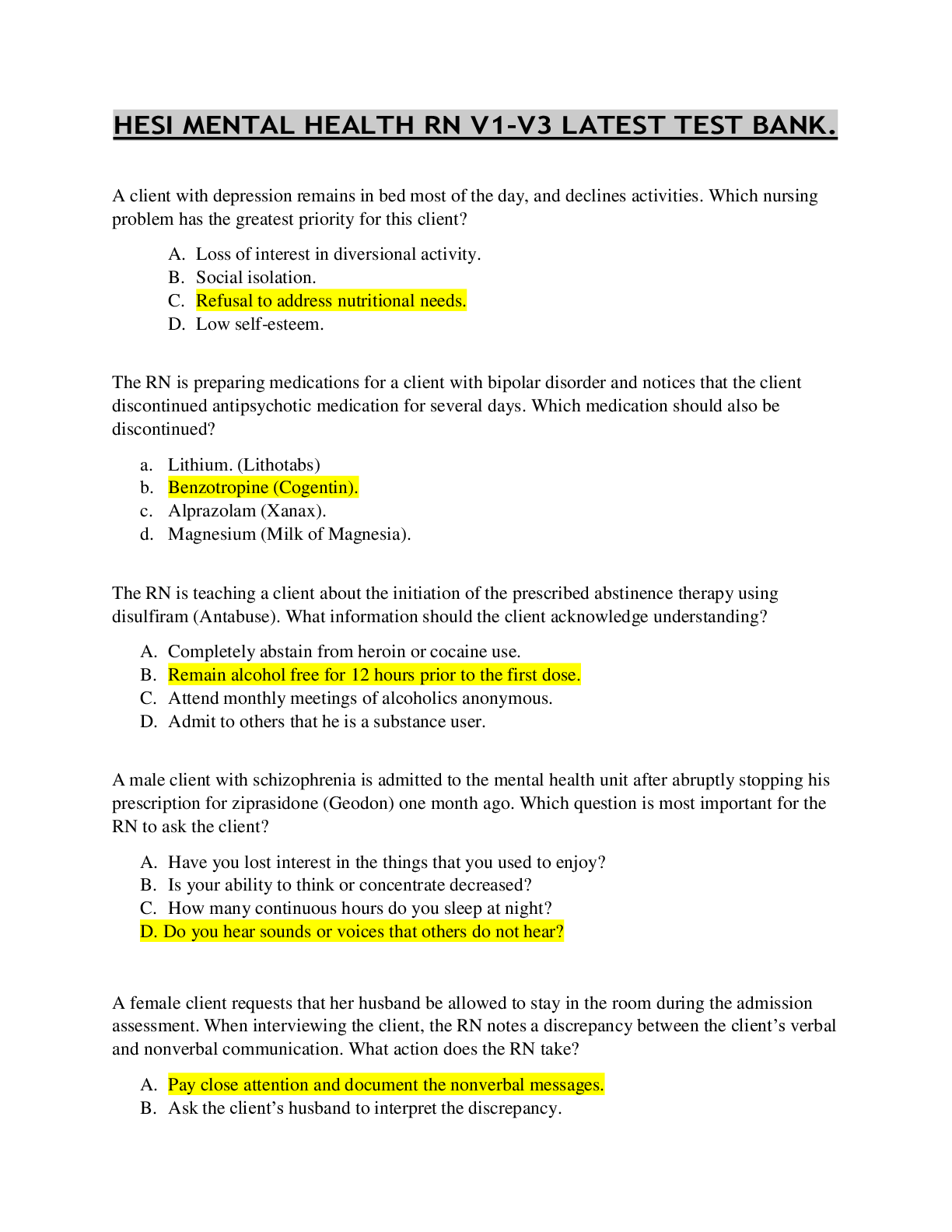
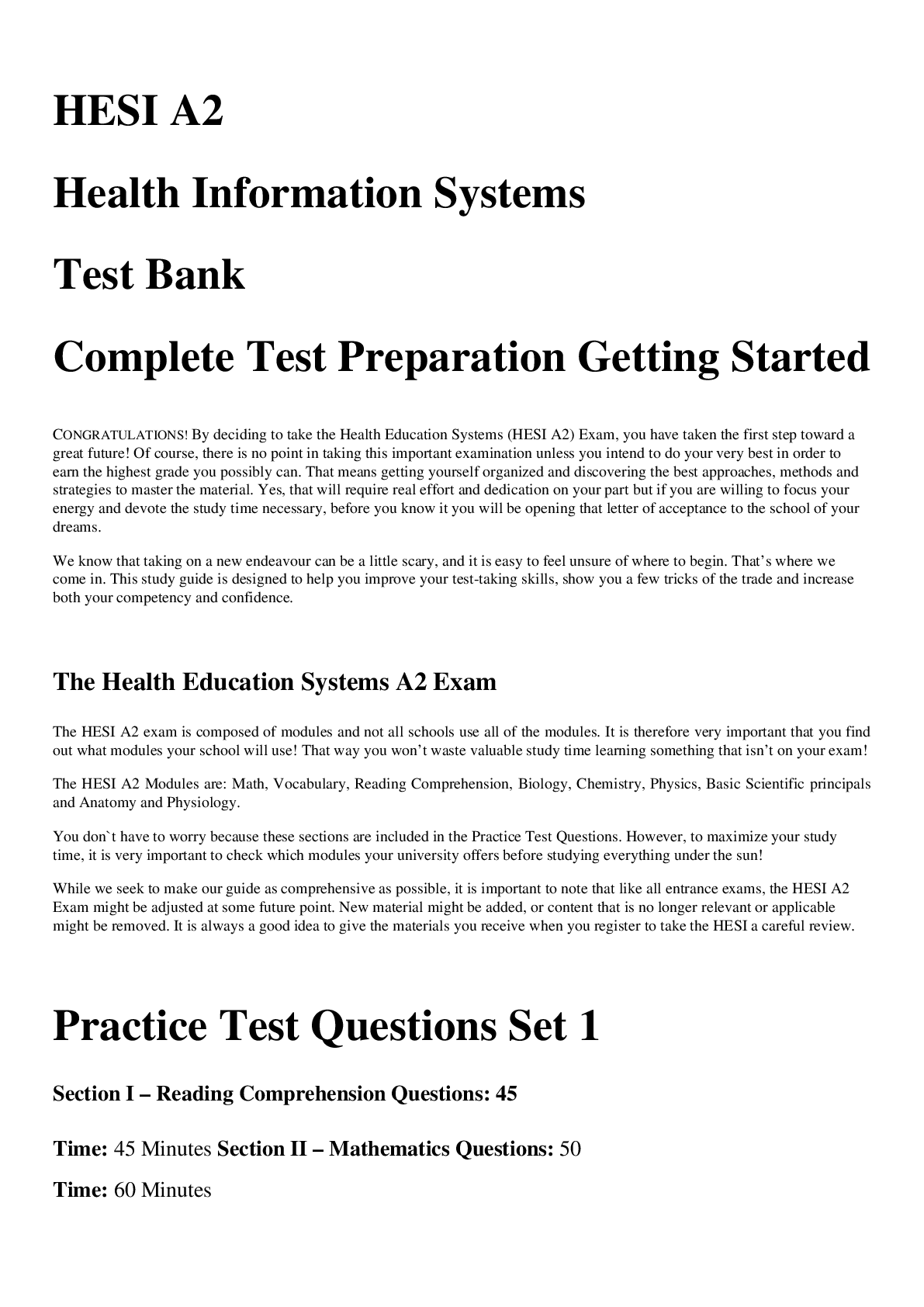
.png)
 LATEST UPDATE.png)

